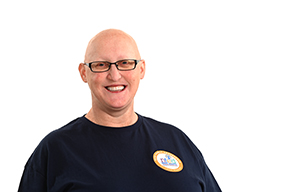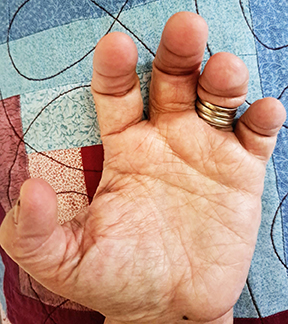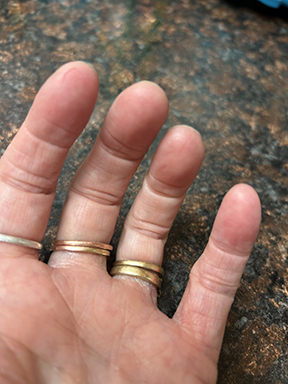It’s rare for someone in the wider community to have no fingerprints. But, in our ectodermal dysplasias community, it’s not rare at all.
Do you have a hard time gripping a pen? Can swiping on your phone be frustrating? You are not alone.
People affected by many types of ectodermal dysplasias share your challenges. Kat has Witkop syndrome and says touch ID on Apple products has never worked for her.
In our new library article, Rylee Moody, an MD candidate at Saint Louis University School of Medicine, explains what adermatoglyphia is. That’s the medical term for “an absence of skin ridges and furrows.” They may also be called dermatoglyphys.
She says, “On the fingertips, these markings are known to be a unique identifier (commonly known as fingerprints), but absence of this textural change can also involve the toes, palms, and the soles.”
Moody cites some of the challenges you can face if your fingerprints are needed to authenticate your identity. It’s often called “immigration delay disease.” She talks about how to overcome the challenge by getting a medical certification letter from your healthcare provider.
Read New ArticleNo Fingerprints Makes Identification Procedures Difficult
Patti, who has an unknown type of ectodermal dysplasia, says she always has difficulty with fingerprinting.
“It has always been challenging to get good prints for me,” Patti said. “Most people can put lotion on their hands and the print will be clearer. With my skin – not so much.”
Erlinda has fewer fingers and no fingerprints, both of which have caused a problem when she’s been fingerprinted.
“I have ectrodactyly-ectodermal dysplasia-clefting (EEC) syndrome and have three fingers on each hand which makes it difficult as well,” Erlinda said. “The scanner and ink method can’t pick up my fingerprints properly. I have to go back several times to get an adequate print each time I need to get fingerprinted.”
Lack of Fingerprints Create Roadblocks

Virginia, who is affected by ankyloblepharon-ectodermal defects-cleft lip and/or palate (AEC) syndrome, recounts all the ways a lack of dermal ridges has been problematic.
“As an individual affected by AEC, I do not have discernable fingerprints. Not having fingerprints may not seem like a big deal, but it has presented a few unique challenges.

The first challenge was when I discovered you need fingerprints for a nursing license. I was fingerprinted locally several times before having to travel to the state capital, twice. Each time, I explained that I am affected by a rare disorder that affects the dermal ridges and supplied a letter from my doctor. In the end, it took five or six attempts and a federal background check to secure my nursing license.
A few years later, the pharmacy at the hospital where I worked decided to switch the medication storage systems over to fingerprint password access only. I explained, several times, that I don’t have fingerprints and it would present a problem with medication passes during my nursing shifts. The pharmacist insisted it would work. It was unfortunate for him that the fact that it didn’t, in fact, was proven during a weekend night shift.
Another challenge presented when my husband and I started our adoption journey. My not having fingerprints disqualified us from international adoption. While we were initially devastated that we were disqualified from international adoption, we’re confident our domestic adoptions led to exactly who was supposed to complete our family.
Nowadays, nearly every tech device tries to convince me to switch to fingerprint password protection. I just chuckle and think, if only it were that easy.”
A Doctor’s Note Worked
Tayon Gunkle had a similar problem to Virginia when she tried to get her nursing license.
“When I was trying to get my Certified Nurse Assistant (CAN) license transferred to Washington, I had to keep redoing my fingerprints for months,” Tayon said. “Finally, I fought the state on it and got them to run a background check without them by supplying a doctor’s note with my diagnosis and explanation as to why my fingerprints are not readable.”
Getting a Grip is Tough

Jill, who is affected by hypohidrotic ectodermal dysplasia (HED), has faced many issues because of those missing dermal ridges.
“Growing up, I was aware that I had difficulty hanging on to ringing bars (also known as monkey bars) or catching a basketball. Later at the grocery store, I had problems separating the plastic bags.


When I had to start getting a fingerprint clearance card to teach, the first time I submitted it, they were rejected as unreadable. I resubmitted with two extra cards and finally got cleared.
Six years later, I sent three sets of prints and a letter of explanation. I got renewed after a manual FBI search. I finally got an identifier number on a set and thought renewing would be easy the next time. Wrong.
This past fall, I had to submit everything online with Department of Public Safety in Arizona. I never heard back and several weeks later, I contacted them about the hold up. They said they couldn’t read them. I was surprised they didn’t have this on file. I had to get a doctor’s letter and resubmit. The process took about 10 weeks.
My son also had issues in the lunch room at school when he needed to use a thumb print to eat. They had to manually put his number in. ABC News did a story called Medical Mystery: No Fingerprints in 2007 which featured Caleb.
We both have issues swiping technology sometimes. I worry about fingerprints being the way to shop and bank.”
Tell Us Your Story
According to the Dr. Moody’s article, there are medical conditions other than ectodermal dysplasias which can also cause someone to not have fingerprints. Or, a person may have a gene that causes them to have the isolated symptom.
But, if you are affected by an ectodermal dysplasia, that’s likely the reason why you don’t have fingerprints or why you may have broken swirls like Lynne Thomas and her brother who both are affected by HED.
What issues have you faced because you don’t have fingerprints? Tell us in the comments below and share what you did to solve the problem.

I have always had problems anytime I need to use fingerprints for identification or access. For my nursing license, it took 3-4 attempts and a trip to state police headquarters where an experienced officer finally got them. He told me in the future, I need to wet my hands before they ink them and only lay my finger tip on the card. If my fingers are pressed or rolled, which is usually how it’s done, the prints aren’t readable. I just skip the fingerprint reader on my phone, it never works.
THANK YOU FOR THIS INFORMATION. WHEN I WAS 23 Y/O, I LIVED IN BALTIMORE MD AND TAUGHT AT A CATHOLIC SCHOOL FOR NEXT TO NO MONEY AS A SPEECH AND HEARING SPECIALIST, UNTIL I COULD FINISH MY MASTERS DEGREE WITH COLLEGE LOANS TO PAY BACK. I HAD BEEN TOLD NO ONE WOULD HIRE ME WITHOUT A MASTERS DEGREE. IT WAS MY DEFINITE IMPRESSION THAT THE INTERVIEWERS WERE CONCERNED BY MY OBVIOUS SKIN PROBLEMS, MOSTLY ON MY HANDS; AS WELL AS, 6 CONGENITALLY MISSING TEETH. AND, YEARS LATER I FOUND MYSELF LIVING AND WORKING IN THE MOST DANGEROUS PLACES SURROUNDED BY LOTS OF PEOPLE WITHOUT A BASIC DEGREE. THE JHH DERMATOLOGIST WHO SAW ME IN 1976 AND TOOK SWEAT GLAND BIOPSIES (AFTER I TOLD HIM “THE HEAT IS KILLING ME IN BALTIMORE, WITH NO A/C IN MY SCHOOL, CAR, OR APARTMENT”) CONFIRMED WHAT I KNEW TO BE ABSENT/OR UNDEVELOPED SWEAT GLANDS. I RECALL SOMEONE TAKING FINGERPRINTS YRS AGO AND COMMENTING ON THE LACK OF RIDGES. BUT I AM MOST CONCERNED ABOUT THE STIFFNESS IN MY FINGER JOINTS, I THINK IS DUE TO ARTHROGRYPOSIS WHICH WAS DIAGNOSED AT BIRTH. IT MAKES IT IMPOSSIBLE FOR ME TO USE CELL PHONES (THE LANDLINE IS STILL USEFUL). SO, I WONDERED HOW MANY PEOPLE WITH ECTODERMAL DYSPLASIAS CAN EASILY USE A CELL PHONE AND IF YOU MIGHT HAVE A GOOD RECOMMENDATION FOR SOMEONE LIKE ME WHO IS ALSO LOSING EYESIGHT. THE JHH DERMATOLOGIST FINALLY TOLD ME, AFTER I WROTE TO ASK HIM RE FOLLOW UP, THAT HE HAD MOVED TO ARIZONA AND THAT HE THOUGHT I HAD A VERY RARE FORM OF ECTODERMAL DYSPLASIA OR SOMETHING ELSE VERY RARE. I TYPED IN BOLD PRINT BECAUSE IT IS EASIER FOR ME TO SEE (I DID NOT WANT YOU TO THINK I WAS SHOUTING AT YOU). THANK YOU.
Earlier today, I posted a comment from Tom Gracik’s (my husband) e-mail
account. I no longer see it. Due to the fact that Tom rarely reads his e-mail, and I am having troubles with my hands and eyes, I would prefer to get any e-mail from NFED sent to my e-mail address (following). I am the person impacted by what i have been told is a “very rare form of ectodermal dysplasia.”
THANK YOU.
Thank you, Virginia. We will update our records. ~Kelley, NFED Director, Family and Community Programs
I dated your husband 1970-1974
Hi Tommy G.
I recently had to be fingerprinted to become affiliated with the Uso my prints were sent to Washington and finally came back they did take a long time but I know that usually does happen nothing was said and I received a badge. However it didn’t work and after a lot of trying and by the way when I was printed we had to keep doing it a lot but finally it was decided after I went back again to be rebatched that I didn’t have any fingerprints and I’d have to just get a numbered too get in funny thing is I was a flight attendant at one time and that was about 20 years ago I was fingerprinted then and again it took a long time but I just thought that’s what happened. I think I did have fingerprints at that time because no one said anything. I don’t understand why I don’t have fingerprints now.
Hi Bunny,
Thank you for taking the time to read our blog post and share your experience. We appreciate you bringing attention to this challenge.
Our neighbor is a licensed daycare provider. She asked if I would go through the state process to become her “emergency substitute”; I agreed. I was fingerprinted twice on a scanning laptop and failed. The company sent someone else with the ink pad roller and I submitted two additional cards. All failed. An Administrator from the state licensing bureau contacted me and asked for permission from each daycare child’s parent. I quilt so I have pin scratches on my fingertips. I am aware my lack of prints can also be associated with medication for CHF.
Hi Donna,
Thank you for reading our blog post and for sharing your experience. We appreciate you shedding light on this challenge.
I work for Transportation Security Administration and don’t have ridges on my hands or feet.
This condition has been passed down through the generations and continues to be passed on .I have been fingerprinted in every way possible through may 23 years in Government service. I’ve been accused of being difficult while being fingerprinted, because fingertips or flat not rounded like those who have fingerprints.
The most ridiculous thing ever asked is if I had toe prints, if I did, I don’t know if they intended on printing my toes and feet.
I wear gloves with the special tips to use my cell phone.
I also use a code to lock my phone or wet fingers help with tasks.
Quite interesting!. In 2019, my job in a care home changed the way we had access to the building. Instead of a password, we were asked to provide our fingerprints, simply by placing our finger in the machine, the main door would open for us. It was impossible for me and another lady. Ultimately, both of us were given new passwords. I have also had problems when travelling overseas because my fingerprints cannot be read while crossing the borderline. I don’t think I have the genetic conditions because I can use mobile screens without difficulty, but, maybe I do not have too many pores and sebaceous glands on my skin because I dont perspire too much, nor can I stand too long in the sun.
I’ve had ME/CFS for a number of years; a percentage of patients with the illness lose fingerprints. Didn’t realize how uncommonly-known this was until a conversation with an (excellent) doctor at Mayo Clinic, who had never heard of the connection. Mine started fading several years ago. I was starting a government job and was fingerprinted for a security clearance. Even after several tries, the officers could not get a clear set…they were extremely nice, making jokes about it. It wasn’t until later I learned this can be a common symptom of the illness. Since that time, my fingertips have continued to thin and smooth out. They’re completely smooth now, which is a nuisance. Its hard to grip things and I can’t touch anything even slightly hot. I have to use a stylus for my cell phone…always. It’s actually uncomfortable to slide my fingers over a cell phone screen. One more symptom of ME/CFS! Not the worst one but I’m always on guard against dropping things!